Chimney Sweeping & Safety Inspection
Safety Inspections and/or Chimney sweeping (commonly referred to as “cleaning”) are recommended yearly by the National Fire Protection Agency (NFPA). Our most important job is to make your chimney as safe as possible. Know that when we sweep your chimney you are getting a chimney sweeping by a certified professional from the National Chimney Sweep Guild (NCSG). Your professional has undergone rigorous and comprehensive training in the classroom along with years of on site job experience. All chimney cleanings come with a safety inspection that is outlined by the NFPA. NFPA is the industry standard for chimney building, and has been adopted as code in Wisconsin. The Chimney cleaning process consists of the following; Laying down clean tarps to protect your floors. Setting up a HEPA vacuum system, which is specifically designed for chimney sweeping, to protect the home from dust and soot. Cleaning the chimney with a heavy duty brush or rotary whip (Power cleaning). Your sweep will clean your flue, smoke chamber, smoke shelf, firebox, damper and cap if needed. Your professional will remove as much Creosote as possible.
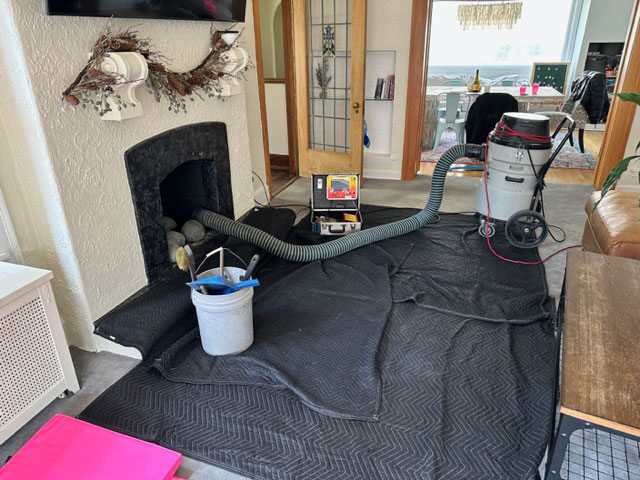
Step by step of chimney Cleaning
- Protect homes interior with tarp and booties on feet.
- Setup HEPA Vacuum system.
- Visually inspect damper area, smoke chamber and start of flue lining system to determine if there are any major defects or if the chimney needs to be swept or just inspected further.
- Power sweep chimney. This involves using a drill with a plastic whip attachment to get rid of as much creosote as possible and make sure flue lining system is free from blockage.
- Clean smoke chamber
- Clean smoke shelf (area behind damper)
- Clean damper
- Scrub firebox
- Visually inspect hearth
- Check basement furnace and water heater for potential carbon monoxide
- Set up ladder and check masonry chimney (brick, stone) and crown.
- When possible check back side of chimney (flashing)
- Go over inspection sheet with customer
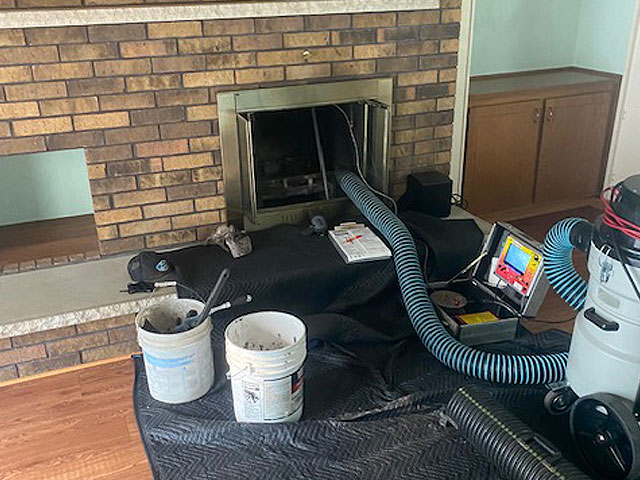
Most common problems with fireplace that a sweep would be able to explain.
- Back drafting ( could be a pressure issue)
- Flaws or deterioration in flue lining system
- Smelling smoke in basement
- Birds or animals in chimney
- Effects from a chimney fire
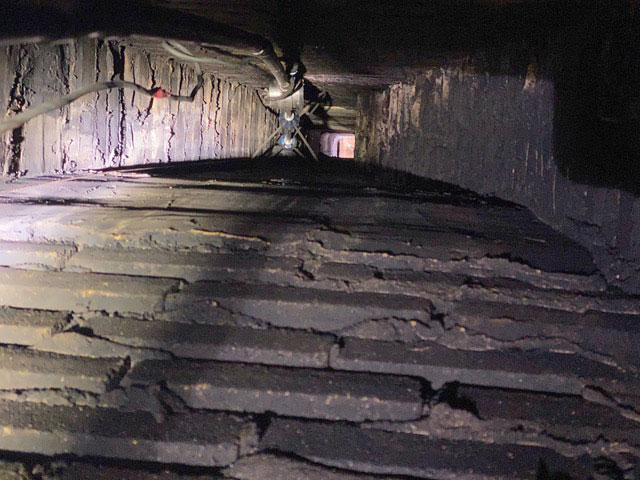
Creosote is a by-product of the smoke produced from fire. It is still flammable in your fireplace system and poses a potential serious threat to homes with active chimneys. Creosote buildup comes in 3 stages. In stage 1 it appears as a fluffy, dusty, popcorn like soot that can be removed relatively easily by your professional sweep by the use of heavy wire brushes. If left alone, over time the creosote buildup will advance to Stage 2. In Stage 2 the creosote will transform into a sticky, tacky tar like substance. Your sweep may not be able to get this out without the use of chemicals. Stage 3 is when the stage 2 buildup has started on fire and it becomes expanded. Excessive creosote can cause chimney fires, which then allow a normal fire to advance throughout the fireplace system.
When the Chimney cleaning is finished your professional will perform a level 1 inspection. This 33 point visual inspection will address all the components of the chimney system. Some examples include outside masonry, crown/wash, cap, flue liner, firebox and damper. If something doesn’t pass inspection, your sweep will want to do a level 2 inspection. A level 2 inspection includes a video scan of the accessible areas of the fireplace flue system and looks at all the accessible areas of the chimney, including the attic, basement/crawl space and any portion of the exterior that may require ladders.
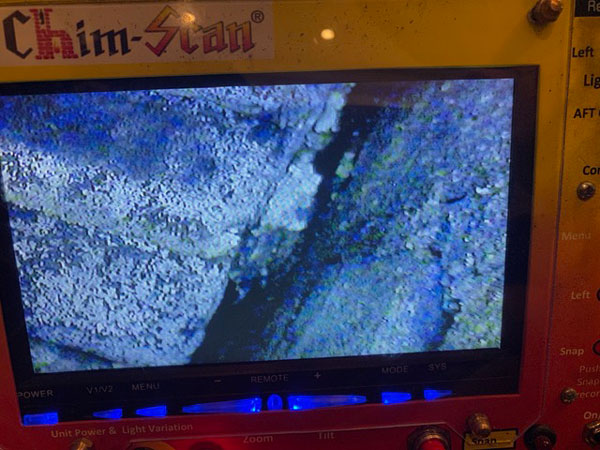
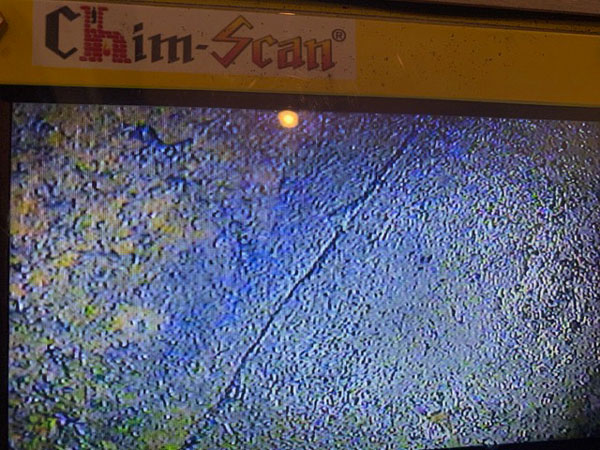
Level 2 inspections should also be done when making changes to your fireplace system such as changing to gas, adding a new wood burning appliance, or having problems such as smoke back drafting. Level 2 inspections are also always done when a house is for sale or if you’ve had a chimney fire. These requirements come from the NFPA.
When the inspection and/or chimney cleaning is complete your sweep will provide you with a form detailing the services performed for your records. All aspects of your fireplace and chimney will be discussed. We treat every fireplace and chimney as if it’s our own.
Chimney Sweeping & Safety Inspection
Safety Inspections and/or Chimney sweeping (commonly referred to as “cleaning”) are recommended yearly by the National Fire Protection Agency (NFPA). Our most important job is to make your chimney as safe as possible. Know that when we sweep your chimney you are getting a chimney sweeping by a certified professional from the National Chimney Sweep Guild (NCSG). Your professional has undergone rigorous and comprehensive training in the classroom along with years of on site job experience. All chimney cleanings come with a safety inspection that is outlined by the NFPA. NFPA is the industry standard for chimney building, and has been adopted as code in Wisconsin. The Chimney cleaning process consists of the following; Laying down clean tarps to protect your floors. Setting up a HEPA vacuum system, which is specifically designed for chimney sweeping, to protect the home from dust and soot. Cleaning the chimney with a heavy duty brush or rotary whip (Power cleaning). Your sweep will clean your flue, smoke chamber, smoke shelf, firebox, damper and cap if needed. Your professional will remove as much Creosote as possible.

Step by step of chimney Cleaning
- Protect homes interior with tarp and booties on feet.
- Setup HEPA Vacuum system.
- Visually inspect damper area, smoke chamber and start of flue lining system to determine if there are any major defects or if the chimney needs to be swept or just inspected further.
- Power sweep chimney. This involves using a drill with a plastic whip attachment to get rid of as much creosote as possible and make sure flue lining system is free from blockage.
- Clean smoke chamber
- Clean smoke shelf (area behind damper)
- Clean damper
- Scrub firebox
- Visually inspect hearth
- Check basement furnace and water heater for potential carbon monoxide
- Set up ladder and check masonry chimney (brick, stone) and crown.
- When possible check back side of chimney (flashing)
- Go over inspection sheet with customer

Most common problems with fireplace that a sweep would be able to explain.
- Back drafting ( could be a pressure issue)
- Flaws or deterioration in flue lining system
- Smelling smoke in basement
- Birds or animals in chimney
- Effects from a chimney fire

Creosote is a by-product of the smoke produced from fire. It is still flammable in your fireplace system and poses a potential serious threat to homes with active chimneys. Creosote buildup comes in 3 stages. In stage 1 it appears as a fluffy, dusty, popcorn like soot that can be removed relatively easily by your professional sweep by the use of heavy wire brushes. If left alone, over time the creosote buildup will advance to Stage 2. In Stage 2 the creosote will transform into a sticky, tacky tar like substance. Your sweep may not be able to get this out without the use of chemicals. Stage 3 is when the stage 2 buildup has started on fire and it becomes expanded. Excessive creosote can cause chimney fires, which then allow a normal fire to advance throughout the fireplace system.
When the Chimney cleaning is finished your professional will perform a level 1 inspection. This 33 point visual inspection will address all the components of the chimney system. Some examples include outside masonry, crown/wash, cap, flue liner, firebox and damper. If something doesn’t pass inspection, your sweep will want to do a level 2 inspection. A level 2 inspection includes a video scan of the accessible areas of the fireplace flue system and looks at all the accessible areas of the chimney, including the attic, basement/crawl space and any portion of the exterior that may require ladders.


Level 2 inspections should also be done when making changes to your fireplace system such as changing to gas, adding a new wood burning appliance, or having problems such as smoke back drafting. Level 2 inspections are also always done when a house is for sale or if you’ve had a chimney fire. These requirements come from the NFPA.
When the inspection and/or chimney cleaning is complete your sweep will provide you with a form detailing the services performed for your records. All aspects of your fireplace and chimney will be discussed. We treat every fireplace and chimney as if it’s our own.

